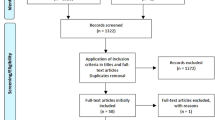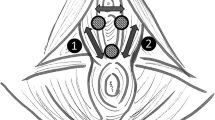Abstract
Introduction and hypothesis
Surface electromyography is commonly applied to measure the electrophysiological activity of the neuromuscular system. However, there is no consensus regarding the best protocol to assess pelvic floor muscles.
Methods
A scoping literature review was carried out in six databases, using MeSH descriptors. It included studies with electromyographic assessment in adult women presenting or not with pelvic floor dysfunction. The results were presented in categories to contribute to the development of a protocol considering the most used parameters for non-invasive assessment of myoelectric activity of pelvic floor muscles.
Results
A total of 1,074 articles were identified, and 146 studies were selected for analysis. The intravaginal probe was used in 80.8% of the studies, the bipolar sensor with metallic plates placed on both sides of the vagina was the most frequent (71.3%), with a reference electrode positioned on the anterior superior iliac spine (33.5%). The supine position with hip and knee flexed (45.2%) was the most frequent position used. Of the studies, 44.5% normalized the data by maximum voluntary contraction (MVC) whereas 44.5% performed an average of 3 MVCs.
Conclusions
The most frequently used protocol for the pelvic floor is the bipolar intracavitary probe with metal plates positioned at 3–9 o’clock and introduced distally to the vaginal introitus with the volunteer in the supine position and the hip and knee flexed with the reference placed on the anterior–superior iliac spine.

Similar content being viewed by others
Data Availability
All data are available upon request.
References
Hodges PW, Sapsford R, Pengel LH. Postural and respiratory functions of the pelvic floor muscles. Neurourol Urodyn. 2007;26(3):362–71.
Rossetti SR. Functional anatomy of pelvic floor. Arch Ital Urol Androl. 2016;88(1):28–37.
Vodušek DB. Anatomy and neurocontrol of the pelvic floor. Digestion. 2004;69(2):87–92.
Boonstra TW, Breakspear M. Neural mechanisms of intermuscular coherence: implications for the rectification of surface electromyography. J Neurophysiol. 2012;107(3):796–807.
Taborri J, Palermo E, Del Prete Z, Rossi S. On the reliability and repeatability of surface electromyography factorization by muscle synergies in daily life activities. Appl Bionics Biomech. 2018;2018:5852307.
Vigotsky AD, Halperin I, Lehman GJ, Trajano GS, Vieira TM. Interpreting signal amplitudes in surface electromyography studies in sport and rehabilitation sciences. Front Physiol. 2018;8:985.
Grape HH, Dedering Å, Jonasson AF. Retest reliability of surface electromyography on the pelvic floor muscles. Neurourol Urodyn. 2009;28(5):395–9.
Hermens H, Freriks B, Merletti R. European Recommendations for Surface ElectroMyoGraphy. Results of the SENIAM project. Enschede: Roessingh Research and Development; 1999.
Merletti R, Hermens H. Introduction to the special issue on the SENIAM European Concerted Action. J Electromyogr Kinesiol. 2000;5(10):283–6.
Hermens HJ, Freriks B, Disselhorst-Klug C, Rau G. Development of recommendations for SEMG sensors and sensor placement procedures. J Electromyogr Kinesiol. 2000;10(5):361–74.
Dewaele P, Deffieux X, Villot A, Amarenco G, Billecocq S, Thubert T. Pelvic floor muscle activation in stress urinary incontinent women: impact of a distraction task. Neurourol Urodyn. 2019;38(3):950–7.
Glazer HI, Romanzi L, Polaneczky M. Pelvic floor muscle surface electromyography. J Reprod Med. 1999;44:779–82.
Kannan P, Winser S, Goonetilleke R, Cheing G. Ankle positions potentially facilitating greater maximal contraction of pelvic floor muscles: a systematic review and meta-analysis. Disabil Rehabil. 2019;41(21):2483–91.
Maizels M, Firlit CF. Pediatric urodynamics: a clinical comparison of surface versus needle pelvic floor/external sphincter electromyography. J Urol. 1979;122(4):518–22.
Petersen I, Franksson C, Danielson C-O. Electromyographic study of the muscles of the pelvic floor and urethra in normal females. Acta Obstet Gynecol Scand. 1955;34(3):273–85.
Ptaszkowski K, Zdrojowy R, Ptaszkowska L, et al. Assessment of bioelectrical activity of pelvic floor muscles depending on the orientation of the pelvis in menopausal women with symptoms of stress urinary incontinence: continued observational study. Eur J Phys Rehab Med. 2017;53(4):564–74.
Voorham-van der Zalm PJ, Pelger RC, van Heeswijk-Faase IC, et al. Placement of probes in electrostimulation and biofeedback training in pelvic floor dysfunction. Acta Obstet Gynecol Scand. 2006;85(7):850–5.
De Fotobimodulação Avet, Do N Claudia Pignatti frederice teixeira.
Flury N, Koenig I, Radlinger L. Crosstalk considerations in studies evaluating pelvic floor muscles using surface electromyography in women: a scoping review. Arch Gynecol Obstet. 2017;295:799–809.
Peters MD, Godfrey C, McInerney P, Munn Z, Tricco AC, Khalil H. Scoping reviews. Joanna Briggs Inst Rev Man. 2017;2015:1–24.
De Oliveira Ferro JK, Lemos A, de Santana Chagas AC, de Moraes AA, de Moura Filho AG, de Oliveira DA. Techniques for registration of myoelectric activity of women’s pelvic floor muscles: a scoping review protocol. JBI Evid Synth. 2021;19(3):727–33.
Page MJ, McKenzie JE, Bossuyt PM, et al. The PRISMA 2020 statement: an updated guideline for reporting systematic reviews. Int J Surg. 2021;88:105906.
Auchincloss C, McLean L. Does the presence of a vaginal probe alter pelvic floor muscle activation in young, continent women? J Electromyogr Kinesiol. 2012;22(6):1003–9.
Auchincloss CC, McLean L. The reliability of surface EMG recorded from the pelvic floor muscles. J Neurosci Methods. 2009;182(1):85–96.
Barnhart KT, Izquierdo A, Pretorius ES, Shera DM, Shabbout M, Shaunik A. Baseline dimensions of the human vagina. Hum Reprod. 2006;21(6):1618–22.
Da Silva CR, Geres BS, Kuriki HU, de Faria Negrão Filho R, Alves N, de Azevedo FM. Análise da reprodutibilidade de parâmetros no domínio da frequência do sinal EMG utilizados na caracterização da fadiga muscular localizada. Motriz Rev Educ Fís. 2012;18:456–64.
Halski T, Ptaszkowski K, Słupska L, Dymarek R. The evaluation of bioelectrical activity of pelvic floor muscles depending on probe location: a pilot study. Biomed Res Int. 2013;2013:238312.
Pereira-Baldon VS, de Oliveira AB, Padilha JF, Degani AM, Avila MA, Driusso P. Reliability of different electromyographic normalization methods for pelvic floor muscles assessment. Neurourol Urodyn. 2020;39(4):1145–51.
Kupa E, Roy S, Kandarian S, De Luca C. Effects of muscle fiber type and size on EMG median frequency and conduction velocity. J Appl Physiol. 1995;79(1):23–32.
Glazer HI, Hacad CR. The Glazer Protocol: evidence-based medicine pelvic floor muscle (PFM) surface electromyography (SEMG). Biofeedback. 2012;40(2):75–9.
Keshwani N, McLean L. State of the art review: intravaginal probes for recording electromyography from the pelvic floor muscles. Neurourol Urodyn. 2015;34(2):104–12.
Burden A. How should we normalize electromyograms obtained from healthy participants? What we have learned from over 25 years of research. J Electromyogr Kinesiol. 2010;20(6):1023–35.
Chmielewska D, Stania M, Sobota G, et al. Impact of different body positions on bioelectrical activity of the pelvic floor muscles in nulliparous continent women. Biomed Res Int. 2015;2015:905897.
Oleksy Ł, Mika A, Sulowska-Daszyk I, Rosłoniec E, Kielnar R, Stolarczyk A. The reliability of pelvic floor muscle bioelectrical activity (sEMG) assessment using a multi-activity measurement protocol in young women. Int J Environ Res Public Health. 2021;18(2):765.
De Luca CJ, Gilmore LD, Kuznetsov M, Roy SH. Filtering the surface EMG signal: movement artifact and baseline noise contamination. J Biomech. 2010;43(8):1573–9.
Stegeman D, Hermens H. Standards for surface electromyography: the European project Surface EMG for non-invasive assessment of muscles (SENIAM). Enschede Roessingh Res Dev. 2007;10:8–12.
Funding
This study was financed in part by the Coordenação de Aperfeiçoamento de Pessoal de Nível Superior—Brasil (CAPES)—Finance Code 001.
Author information
Authors and Affiliations
Contributions
J.K.O. Ferro: creating the study idea, protocol/project development, data collection, management of data analysis, and manuscript writing/editing; A. Lemos: protocol/project development, manuscript editing; A.C. Santana Chagas: data collection, management of data analysis; A.A. de Moraes: data collection; manuscript editing. A.I.S. de Oliveira-Souza: management of data analysis and manuscript writing/editing; D.A. de Oliveira: creating the study idea, protocol/project development, and manuscript editing.
Corresponding author
Ethics declarations
Ethical Approval
Ethical approval was not needed as this is a scoping review that did not involve any patients.
Conflicts of Interest
None.
Additional information
Handling Editor: Tamara Serdinšek
Editor in Chief: Kaven Baessler
Publisher’s note
Springer Nature remains neutral with regard to jurisdictional claims in published maps and institutional affiliations.
Supplementary information
Below is the link to the electronic supplementary material.
Rights and permissions
Springer Nature or its licensor (e.g. a society or other partner) holds exclusive rights to this article under a publishing agreement with the author(s) or other rightsholder(s); author self-archiving of the accepted manuscript version of this article is solely governed by the terms of such publishing agreement and applicable law.
About this article
Cite this article
de Oliveira Ferro, J.K., Lemos, A., de Santana Chagas, A.C. et al. Techniques for Registration of Myoelectric Activity of Women’s Pelvic Floor Muscles: A Scoping Review. Int Urogynecol J (2024). https://doi.org/10.1007/s00192-024-05744-0
Received:
Accepted:
Published:
DOI: https://doi.org/10.1007/s00192-024-05744-0




